Hi Again Everyone,
If you thought part one was really good, you're going to enjoy part two even more. So, once again, sit back, relax, and read on...
Take Care,
Lito
------------------------------------------------------------------------------
Solving Styles: Reverse Engineering Archie Moore and the Lock, part 2
By Connor Ruebusch on Jun 12 2014
Yesterday, we explored the history behind the famous cross-armed guard of Archie Moore, also known as the Lock. As a basic technique, the cross-armed guard goes back into the early 19th century at least, but it was Archie Moore who made it his signature. Today we will look into his unique application.
Until the time of George Foreman, and later Bernard Hopkins, Moore was the oldest fighter to ever hold a world title, as good an endorsement of his defensive prowess as one could ask for. And while he may not have held his belt as long as those men, he spent far longer than either in the sport, winning his first professional bout in 1935 and fighting his last in 1963. In addition, Moore still holds, and probably always will, the record for most knockouts with an astounding 131 fights ended inside the distance, making him one of the most complete fighters to ever set foot in the squared circle.
All of this points to the one thing that truly made Moore great, that is, his mind. He was not an exceptional athlete, nor did he possess an iron jaw, nor incredible speed. What Moore possessed that gave him such outstanding longevity was a system. There was no situation that could arise in the ring that Moore did not have a prepared and meticulously trained answer to. In a 1955 interview with Sports Illustrated, Moore said of his fighting philosophy, "I try to build a bridge. With each punch I try to build a bridge so I can escape over it if something goes wrong. That's what you call escapology. That's what I call escapology."
Moore had many such "bridges" in his system. In an attempt to "reverse engineer" Archie's game, I've put together one of my geekiest creations yet. Ladies and gentlemen, I give you the Archie Moore flow chart.
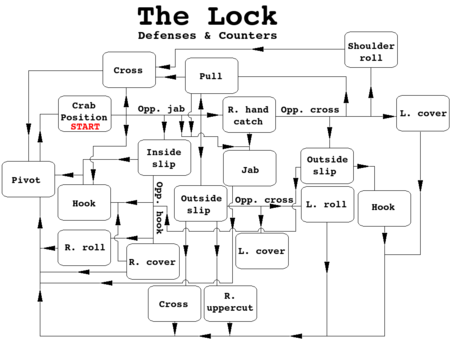
(Click to enlarge)
Now, before we explore some of these paths, I should point out that this is by no means a complete layout of Moore's system. In this chart we have his set responses to three basic punches--the jab, cross, and hook, and each path assumes that the opponent has led with the jab first. It doesn't account for such subtleties as range and angle, which would play a huge part in determining Moore's punch selection. Don't let this fool you into thinking that Moore was at a loss if his man started his assault with a hook, or a lead right; likewise, don't let the fact that my chart doesn't include Archie's various leads and feints lead you to believe that he was strictly a counter fighter. In 219 trips to the prizefighting ring, Moore made it very clear that he had a plan for every eventuality, and a tool to account for every possible opening.
It would simply be too difficult to put together, and likely to read a chart that covered every technique in Moore's vast system. Nonetheless, this pared-down version gives a pretty good idea of Moore's basic defenses and counters against an average, run-of-the-mill boxer.
Many Answers
One of the keys to Moore's incredible success was the number of options to which he could turn in response to each attack from his opponent. In 1958, Moore defended his light heavyweight title for the 7th time against Yvon Durelle, and in the first round paid the price for using too predictable a defense against the tough Canadian.

About a minute into round one Durelle caught Moore cold. Before this sequence Moore had already settled into a predictable pattern, and you can see the continuation of that pattern at the beginning of this GIF. Durelle, right hand cocked, prods Archie with a jab, and the Mongoose slips it to the outside, attempting to counter with a right hand. To his immense credit, Durelle tries the jab again, and drops a perfectly timed right hand immediately behind it. Moore slips the jab the same exact way, perhaps looking for another counter right, and puts his head right in the path of Durelle's punch.
This is the risk of having only one answer to a given threat. Why choose this, an example of Moore getting dropped, as the first in an article about Moore's prowess? Well, Archie Moore was not the kind of man to make the same mistake twice. For those of you who have never seen this fight: Moore, despite looking all but dead after that right hand above, got up, adapted, and fought ten more rounds before knocking Durelle out (though he would go down twice more before the end of the first).
Once Durelle proved he could put a killer punch behind that jab, Moore became obsessed with defeating it. First, he began slipping the jab to the inside, preventing it from blinding him to a potential follow-up right hand. Throughout round two he began circling to Durelle's right, ostensibly moving into his right hand, but actually moving away from the left he needed to set it up, and therefore forcing Durelle to either constantly adjust or else throw a naked right hand that proved much easier to dodge. Of course, Moore's defense alone didn't get him 131 knockouts--his counters did, and Moore didn't even need a half round of recovery before he started countering with ill intent. Let' go to the flow chart.
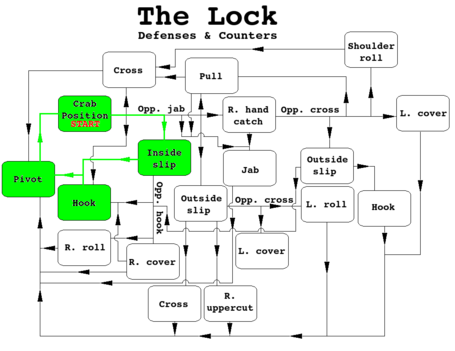
(Click to enlarge)
Slipping inside the jab, Moore ends up with his head slightly forward and his weight on his left foot. From this position, his left hook is cocked and loaded, and Moore has never been shy about throwing it.

Note how Moore is constantly pivoting to Durelle's right, even as he throws his punches and avoids those of his opponent. This keeps Durelle from setting his feet and throwing combinations of punches while Moore recovers from the brutal first round.
As the fight wore on, Moore's defense of the jab became more and more varied, until Durelle began to forget about the reason he was throwing it in the first place. Instead of throwing combinations off of his jab, Durelle became so frustrated that he couldn't land it, and so flummoxed by the fact that Moore was constantly in different positions after avoiding it, that he repeatedly eschewed his power punches altogether. Moore, in response, grew ever more comfortable in his ability to counter it, even going back to the outside slip that had nearly gotten him knocked out in the opening frame.
As the chart says, so Moore does.
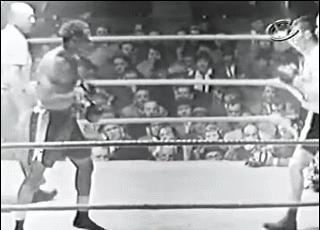
Here, tired and frustrated in the 10th round, Durelle feints. Moore reacts, throwing up his right hand to catch Durelle's jab. Durelle commits to a real jab next, but Moore doesn't go back to the same defense. Instead, he slips outside the jab and comes back over the top with a heavy right hand. Still wary of Durelle's power, Archie doesn't pounce to follow up on his staggered foe, but instead cautiously reestablishes the range with a short step back.
Continuing on the next post...


 Thanks:
Thanks:  Likes:
Likes:  Dislikes:
Dislikes: 

 Reply With Quote
Reply With Quote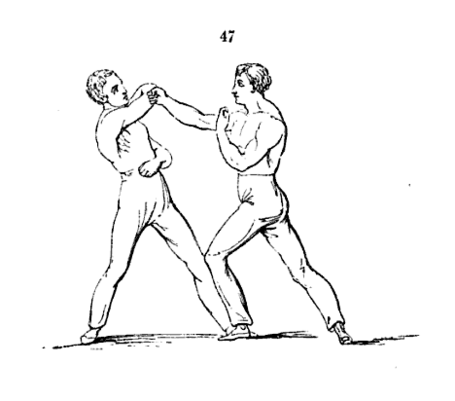





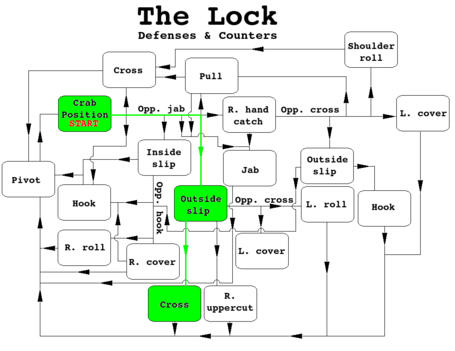


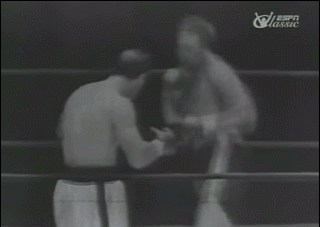


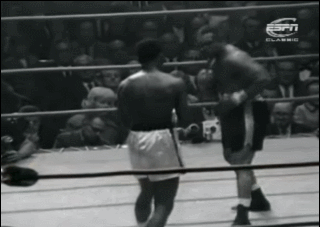



 .
.





Bookmarks